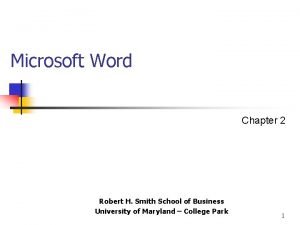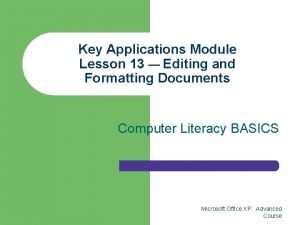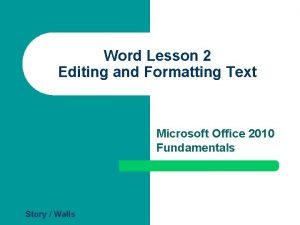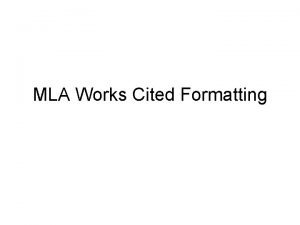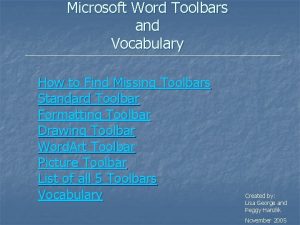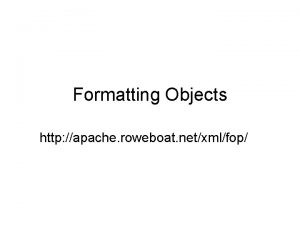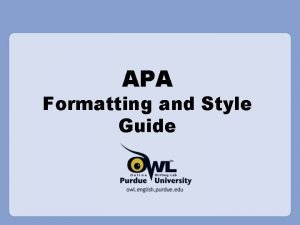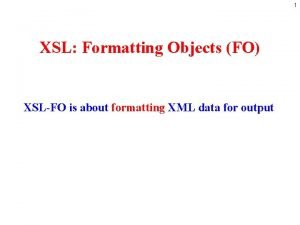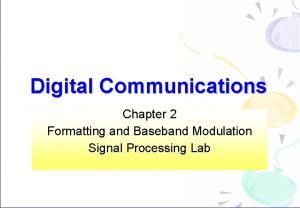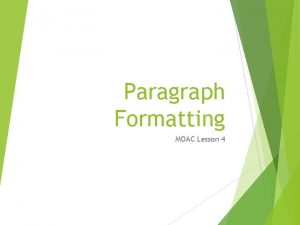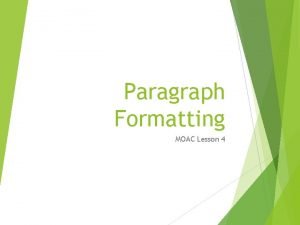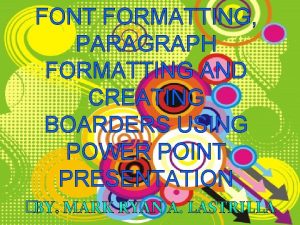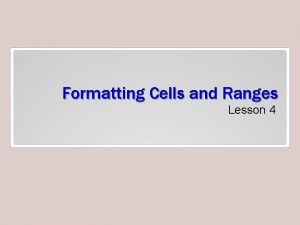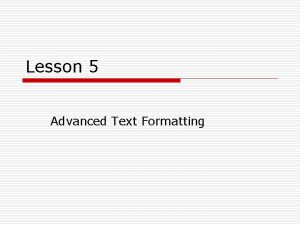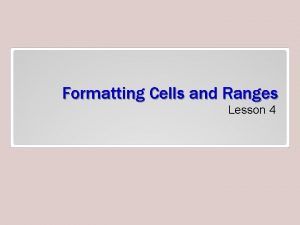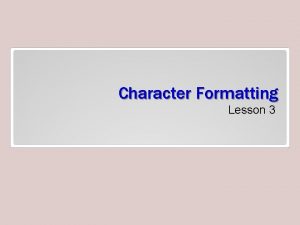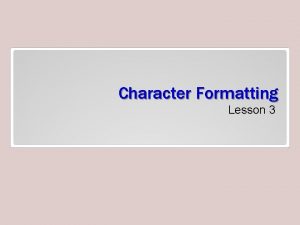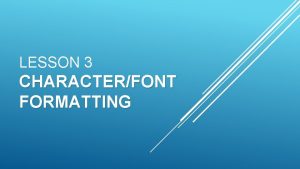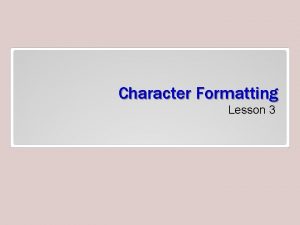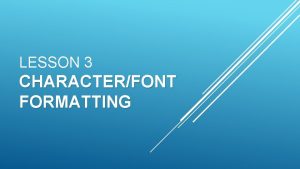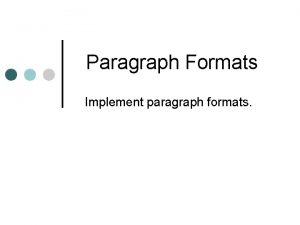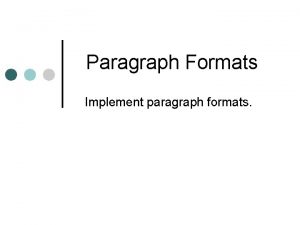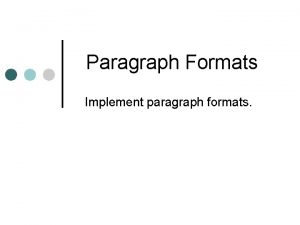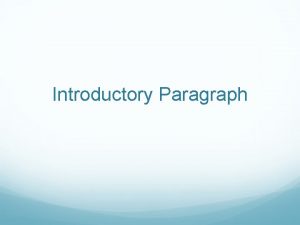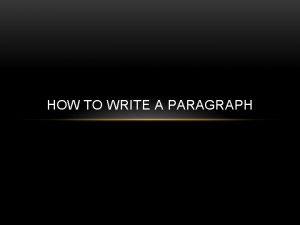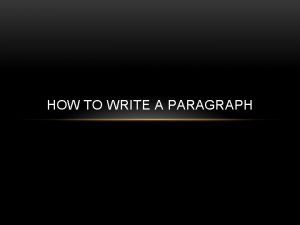Paragraph Formatting Lesson 4 Software Orientation The Paragraph




















- Slides: 20

Paragraph Formatting Lesson 4

Software Orientation The Paragraph dialog box contains Word’s commands for changing paragraph alignment, indentation, and spacing. The Indents and Spacing tab of the Paragraph dialog box is shown below.

Paragraph Formatting Process of changing the appearance of a paragraph of text Paragraph formatting is an essential part of creating effective, professionallooking documents. Includes: Alignment Borders Line and Shading Spacing Indentation

Indents Indent: Blank space inserted between text and the left or right margin. Indents can be used to set paragraphs off from other text in your documents. The commands for indenting paragraphs are available in the Paragraph group on the Home ribbon, as well as in the Paragraph group on the Page Layout ribbon. Both groups will open the paragraph dialog box. Indents can also be set on the ruler. Indent markers as they appear on the ruler

Indents First Line Indent: Inserts blank space between the left margin and the paragraph Default tab is 0. 5” Hanging Indent: Begins with the first full line of text in a paragraph at the left margin, all of the remaining lines in the paragraph are then indented from the left margin (used in Works Cited and legal documents) Negative Indent: Extends the paragraph text into the left margin

Paragraph Alignment Refers to how text is positioned between a document’s margin Horizontal alignment refers to how text is positioned between the left and right margins. There are four types of horizontal alignments: left align, center align, right align, or justify. Default alignment is left Vertical Alignment refers to how text is positioned at the top margin, at the center of the page, or at the bottom of the page Page Layout Ribbon > Page Setup Dialog Box > Layout Tab > Page > Vertical Alignment Default alignment is Top

Paragraph Alignment - Horizontal Align Left-(Ctrl+L) Center-(Ctrl+E) Align Right-(Ctrl+R) Justify-(Ctrl+J)

Paragraph Alignment Vertical alignment refers to how text is positioned between the top and bottom margins of the page. Top of the page vertical alignment is the default when launching Word. Centered vertical alignment places the text evenly between the top and bottom margins. Bottom vertical alignment places text next to the bottom margin of the document.

Shading a Paragraph

Border Paragraph or Text Borders can add interest and emphasis to paragraphs or text. You can apply a border by clicking the Border button in the Paragraph group on the Home tab. To change the border style, click the dropdown arrow next to the Border button. For additional options, click the Borders and Shading option on the Border menu to open the Borders tab of the Borders and Shading dialog box.

Border Paragraph or Text You can choose a number of border colors and styles in this dialog box, or you can remove a border completely. This dialog box also contains tabs for page border options and shading.

Line & Paragraph Spacing You can determine how much space separates lines of text, and you also can set the spacing between paragraphs. By default, Word sets line spacing (the space between each line of text) to 1. 08 Paragraph spacing, which affects the space above and below paragraphs, is set to 8 points after each paragraph by default. The higher the point size is, the greater the space between paragraphs.

Line Spacing Amount of vertical space between lines of text Single Space – Ctrl + 1 Double Space – Ctrl + 2 1. 5 Lines – Ctrl + 5 At Least – Provides the minimum amount of space for a line of text Exactly – provides an exact amount of space for a line of text Multiple – sets the amount of space (double, triple, quadruple)

Line & Paragraph Spacing New in Word 2013 is the Design tab, which includes Paragraph Spacing. When selected on the Design tab the spacing will be applied to the entire document. The table below provides additional information regarding line and paragraph spacing options and descriptions.

Bulleted Lists Series of paragraphs, each beginning with a bullet character Bulleted lists are an effective way to format lists of items that don’t have to appear in any specific order. (Use numbered lists for items in a set order. ) Items in a bulleted list are marked by small icons—dots, diamonds, and several styles. You can change existing lines of text into a bulleted list, create levels within a bulleted list, and insert a symbol or picture as a bullet.

Change the Bullet List An unordered list such as bullets appears with no rank over the others. Changing the bullet list level can change the appearance of the bullet and indentation. As the indent increases the level decreases. Move up a level is to Promote (reduce indent) Move down a level is to Demote (increases indent) Choose to Change List Level from the Bullet drop-down arrow. You can also change the bullet to a Picture or Symbol by choosing Define New Bullet

Numbered List Create a Numbered list if the contents need to appear in a particular order. You can quickly add numbers to existing lines of text to create a list, or Word can automatically create a numbered list as you type. A numbered list can use numbers, letters, or Roman numerals.

Multilevel List Word provides a multilevel feature that is used for outlines and other documents that require many levels—these levels can be a combination of letters and numbers. You can change a multilevel list by changing the list level, defining a new multilevel list, or defining a new list style. The same methods are used as when modifying bullets and numbering lists when increasing or decreasing the levels. You can Sort a single-level list in much the same way that you sort a column in a table. As an example, you can use the multilevel list for outlining your research paper.

Setting Tabs are used to align text or numbers nicely in columns in your document. To set Tabs use the Tabs dialog box or the Ruler. By default, left-aligned Tab stops are set every half-inch (. 5”). Tabs are part of paragraph formatting. When the Enter key is pressed, the tab settings are carried forward into the next paragraph. After Tabs are set, press the Tab key; the insertion point moves to the position set. This is referred to as a Tab Stop. To remove Tabs drag the marker off the ruler line or select Clear in the Dialog box. Tab Leaders are symbols such as dots or dashes that fill the space before a Tab. Key Tab Stop position here.

Setting Tabs Left Center Right Decimal Tabs can also be set by using the ruler To set a Tab at a different position on the ruler, you can click and drag the tab selector to the new location. Left Tab – text is left aligned Right Tab – text is right aligned Center Tab – centers the text Decimal Align – aligns numbers at the decimal point Bar Tab – places a bar in the document Bar
 Paragraph formatting
Paragraph formatting Paragraph formatting
Paragraph formatting Paragraph formatting
Paragraph formatting Polycentric company
Polycentric company Editing and formatting text
Editing and formatting text What is a reference page in apa format
What is a reference page in apa format Owl mla works cited
Owl mla works cited Standard toolbar ms word
Standard toolbar ms word What is mixed punctuation
What is mixed punctuation Apache fop
Apache fop Abstract page apa
Abstract page apa Match destination formatting excel
Match destination formatting excel Xsl-fo
Xsl-fo Internal monologue writing
Internal monologue writing Gambar toolbar formatting
Gambar toolbar formatting Magnetic disk read and write mechanism
Magnetic disk read and write mechanism Gambar toolbar formatting
Gambar toolbar formatting Sqlplus format output
Sqlplus format output Which hidden formatting symbol represents a tab character
Which hidden formatting symbol represents a tab character How to use punctuation in quotes
How to use punctuation in quotes Formatting in digital communication
Formatting in digital communication

